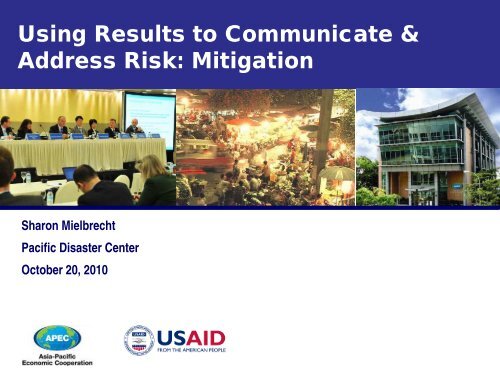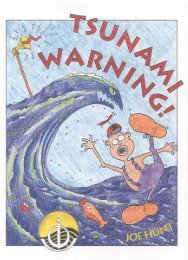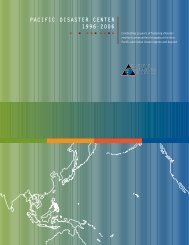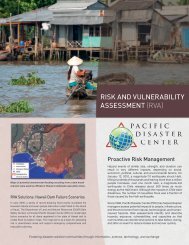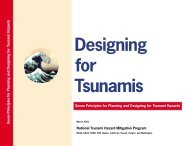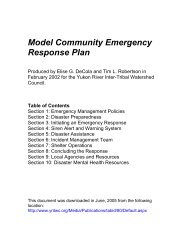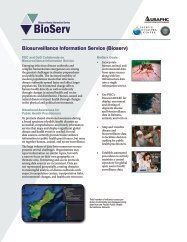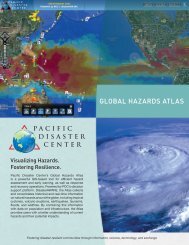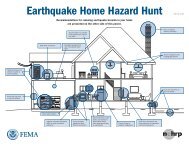Mitigation - VinAWARE - Pacific Disaster Center
Mitigation - VinAWARE - Pacific Disaster Center
Mitigation - VinAWARE - Pacific Disaster Center
Create successful ePaper yourself
Turn your PDF publications into a flip-book with our unique Google optimized e-Paper software.
Using Results to Communicate &<br />
Address Risk: <strong>Mitigation</strong><br />
Sharon Mielbrecht<br />
<strong>Pacific</strong> <strong>Disaster</strong> <strong>Center</strong><br />
October 20, 2010
Using Results to Communicate and Address Risk<br />
MITIGATION<br />
1
<strong>Mitigation</strong><br />
• “The lessening or limitation of the adverse<br />
impacts of hazards and related disasters.”<br />
(UNISDR)<br />
• Includes activities that<br />
eliminate or reduce the<br />
impacts of a disaster.<br />
2
<strong>Disaster</strong> Risk Reduction Process<br />
3
Steps to Address Risk<br />
1. Review and assess current mitigation strategies;<br />
2. Identify potential mitigation projects;<br />
3. Establish criteria for project prioritization;<br />
4. Identify benefits;<br />
5. Determine costs;<br />
6. Prioritize according to established criteria; and<br />
7. Develop detailed mitigation project specifications<br />
for priority projects.
<strong>Mitigation</strong> Measures<br />
<strong>Mitigation</strong> Measures<br />
Structural<br />
Informational<br />
Strategic<br />
• Upgrade infrastructure<br />
• Strengthen design and<br />
safety standards for new<br />
buildings<br />
• Retrofit existing buildings<br />
• Secure and/or elevate<br />
contents<br />
Adapted from DPRI<br />
• Education, training,<br />
outreach<br />
• Public information<br />
• Programs/exercises to<br />
increase readiness,<br />
response, recovery<br />
• Land use planning,<br />
zoning<br />
• Local capacity building<br />
initiatives<br />
• Laws, policies, and<br />
regulations<br />
• Financial resources<br />
development<br />
• Environmental controls
<strong>Mitigation</strong> Measures<br />
• Structural<br />
– Engineering measures can help reduce the<br />
likelihood or impact of a disaster event<br />
‣Wind-resistant shutters<br />
‣Stronger transportation containers<br />
‣Fire sprinkler systems<br />
‣Fire retardant materials<br />
‣Dykes<br />
‣Others<br />
•6
<strong>Mitigation</strong> Measures<br />
• Information<br />
– Studies and reports<br />
– Labeling of hazardous materials<br />
– Presentations to lawmakers, civic groups,<br />
professional societies, and corporate<br />
management.<br />
– Using the media to help inform the public<br />
– Others<br />
•7
<strong>Mitigation</strong> Measures<br />
• Codes and Ordinances<br />
– Laws are a primary tool for mitigation<br />
– Codes and regulations are mechanisms for<br />
implementing these laws<br />
‣Building and zoning codes<br />
‣Plumbing and electrical codes<br />
‣Public health ordinances<br />
‣Fire and life safety codes<br />
‣Hazardous materials regulations<br />
‣Dam inspection regulations<br />
‣Traffic Codes<br />
•8
Cost to Benefit Example<br />
Cost-Benefit of FEMA mitigation grants<br />
between 1993- 2004<br />
Every $1 spent saves tax payers $4<br />
http://econ.appstate.edu/RePEc/pdf/wp0602.pdf
Identifying <strong>Mitigation</strong> Actions<br />
• Is Exposure or Vulnerability reduced by<br />
the mitigation action<br />
– Number of people affected<br />
– Area affected by hazard<br />
– Number of properties affected by hazard<br />
– Property damage ($)<br />
– Loss of use/function<br />
– Loss of life<br />
– Injury<br />
10
Identifying <strong>Mitigation</strong> Actions<br />
Conduct a high-level review of potential Benefits for each<br />
<strong>Mitigation</strong> Action: ___________________<br />
11
Identifying <strong>Mitigation</strong> Actions<br />
Conduct a high-level review of potential Costs for each<br />
<strong>Mitigation</strong> Action: ___________________<br />
12
Measuring <strong>Mitigation</strong> Success<br />
Marikina City Example<br />
1992 Flood Areas<br />
10446 residences impacted<br />
450 businesses impacted<br />
2004 Flood Areas<br />
Reduced to 4877 residences (54%)<br />
Reduced to 289 businesses (36%)<br />
Marikina City flood mitigation success prompts Mayor to set a goal<br />
to eliminate residential flooding by 2015
Identify & Evaluate <strong>Mitigation</strong> Actions<br />
Example: City Hall
Identify & Evaluate <strong>Mitigation</strong> Actions<br />
Example: City Hall<br />
• Relationship to hazard areas<br />
• Type of service provided<br />
• Value to the community<br />
• Revenue generation<br />
• Number of employees<br />
• Potential impacts on services, revenue,<br />
wages due to functional downtime<br />
• Storage of hazardous materials
Identify & Evaluate <strong>Mitigation</strong> Actions<br />
Example: City Hall<br />
• Provides income for 2000 employees, 800<br />
permanent jobs, additional temporary jobs.<br />
• Houses the Mayor’s office, finance, business and<br />
treasury, police force, medical emergency group,<br />
settlement office, fees and permits collection<br />
departments, radio station, communications base,<br />
training center, computer facility managing city<br />
records, motor pool, warehouse with materials and<br />
supplies, vital statistics, and engineering equipment.<br />
• Provides settlement services affecting 130,000<br />
people, medical and dental services, and collects<br />
tax revenues of over 1 billion Pesos per year, and<br />
fees and permits of over 35 million Pesos per year.
Identify & Evaluate <strong>Mitigation</strong> Actions<br />
Example: City Hall<br />
What <strong>Mitigation</strong> Options and Costs for City Hall<br />
• What are mitigation options to reduce known<br />
vulnerabilities to specific hazards<br />
• What are the costs for mitigation for City Hall<br />
Benefit-Cost Analysis for <strong>Mitigation</strong> Options<br />
• Physical assets can be valued.<br />
• Revenue generation can be valued.<br />
• Services rendered to the community can be valued.<br />
• Avoided hazard impacts can be valued.
STAPLEE Evaluation Criteria<br />
CRITERIA<br />
Social<br />
Technical<br />
Administrative<br />
Political<br />
Legal<br />
Economic<br />
Environmental<br />
• Community acceptance<br />
• Effect on segment of population<br />
• Technical feasibility<br />
• Long-term solution<br />
• Staffing<br />
• Funding allocated<br />
• Political support<br />
• Local champion<br />
• State authority<br />
• Existing local authority<br />
• Benefit of action<br />
• Cost of action<br />
• Effect on land / water<br />
• Effect on endangered species<br />
• Effect on HAZMAT / waste sites<br />
CONSIDERATIONS<br />
• Secondary impacts<br />
• Maintenance / operations<br />
• Public support<br />
• Potential legal challenge<br />
• Contributes to economic goals<br />
• Outside funding required<br />
• Consistent with community<br />
environmental goals<br />
• Consistent with National laws<br />
18
Evaluation and Prioritization<br />
Source: FEMA<br />
19
Evaluation and Prioritization<br />
EXAMPLE<br />
Source: FEMA<br />
20
<strong>Mitigation</strong><br />
QUESTIONS<br />
21
Using Results to Communicate and Address Risk:<br />
<strong>Mitigation</strong><br />
• Contributing Authors<br />
– Sharon Mielbrecht, <strong>Pacific</strong> <strong>Disaster</strong> <strong>Center</strong><br />
– Erin Hughey, PhD, <strong>Pacific</strong> <strong>Disaster</strong> <strong>Center</strong><br />
– Heather Bell, PhD, <strong>Pacific</strong> <strong>Disaster</strong> <strong>Center</strong><br />
• Published Source Materials<br />
– <strong>Pacific</strong> <strong>Disaster</strong> <strong>Center</strong>. 2010. Course materials developed for the Ministry of<br />
Agriculture and Rural Development (MARD) Natural <strong>Disaster</strong> Risk Management<br />
Project: Education and Training Program. Hanoi, Vietnam, March-May 2010.<br />
– <strong>Pacific</strong> <strong>Disaster</strong> <strong>Center</strong>. 2004. Multi-hazard Urban Risk Assessment for Marikina<br />
City, Philippines and Guidelines for Implementing Multi-hazard Risk Reduction<br />
Strategies for an Urban Environment. Marikina City, Philippines, January-<br />
December 2004.<br />
– United States Federal Emergency Management Agency (FEMA) (2010). Benefit-<br />
Cost Analysis Course (FEMA BCA).<br />
– United States Federal Emergency Management Agency (FEMA) (2007). Using<br />
Benefit-Cost Review in <strong>Mitigation</strong> Planning (FEMA 386-5).


